As an Amazon Associate I earn from qualifying purchases.
I can’t remember the first time I ate a clam. But I do know it was far earlier than my first oyster, or scallop, or mussel. And it was likely this Maine clam chowder recipe that’s been in my family for more than a century.
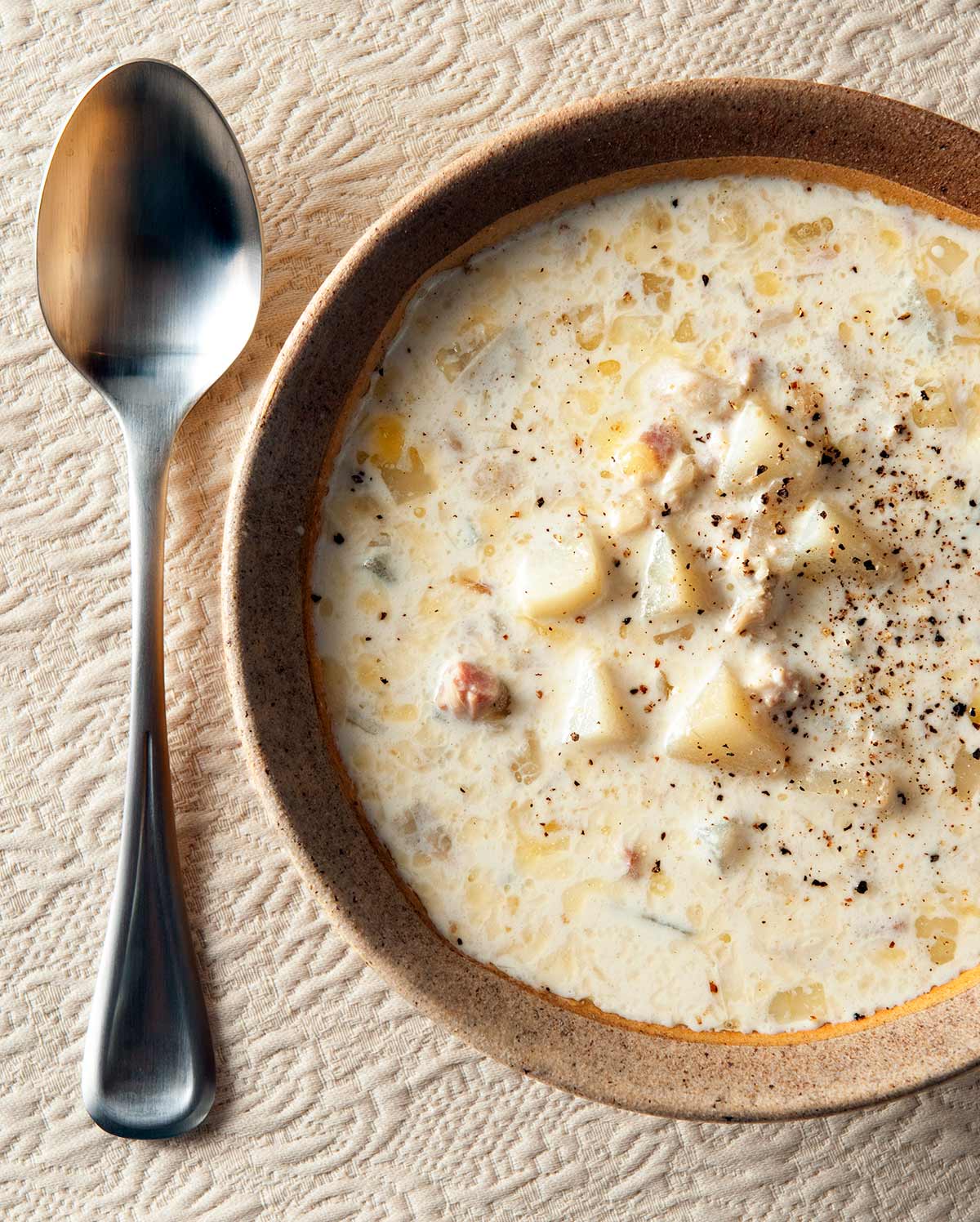
Clams are in my family’s DNA. My mom, after all, is a native of Ipswich, Massachusetts. And if there is a place more clam-centric than Ipswich, I can’t think of it; there is even a clam nicknamed the “Ipswich clam.” We know it as the steamer.
To me, clams mean vacation. Summertime. Happiness. I’ve written about my fond memories of digging hard-shell clams on Block Island both in this space and in my book, and even today, 3,000 miles from New England, clamming in the mud flats of California brings joy to my heart the way nothing else really does.
I owe all of this to my mom. It was she who taught me how to dig and eat clams. So imagine my surprise when it finally dawned on me, sometime in my teenage years, that mom really doesn’t care for clams all that much.
Don’t get me wrong: She led our clamming expeditions on Block Island, her version of stuffed clams is one of my favorites, and no one else’s New England clam chowder can ever compare to hers. I only learned it was a Maine clam chowder later in life. More on that in a bit.
For mom, clams and clamming bring back bittersweet memories of her childhood on coastal New England. It was just after World War II, and while times weren’t so hard as in the Depression, the beauty of the shoreline was mixed with some hard, smelly work.
Every Friday during those summers it was up to mom and my Uncle David to gather steamer clams for dinner and quahogs for chowder. I asked her to tell me about it a few years ago, and this is her story:
The steamer or ‘piss clams’ were dug at low tide and we walked to the flat from our cottage in Ipswich carrying our large clam bucket, a pitchfork and a small tin can for the sea worms. [Mom sold them as bait.]
The steamers were plentiful then and the water wasn’t polluted so it was safe to eat the clams that we dug. The clams were easy to find, as when the tide goes out the clams bury themselves deep into the mud and leave a small round air hole, which is a dead giveaway that the clam is there. For some reason the clams like to all live together in the same area, so once we started to dig we found plenty of them.
We tried hard not to pierce their soft shells with the pitchfork and mostly were successful. We did this by not digging quite as deep as where the clams lay and then used our hands to finish the job. As we dug away the mud, we sometimes got cuts on our hands from the sharp empty clamshells that were sticking up at odd angles. No manicure in those days!
But what a delight it was to reach into the mud and come up with a juicy, spitting (they spit out a long stream of salt water when picked up to try to frighten you away), healthy steamer clam to plunk into the bucket!
…After we had a bucket full of steamer clams, we got our rowboat and went to the enormous sand bar off the south end of Plum Island, which juts out into Ipswich Bay. We would pull our boat up onto the bar and drop the anchor. If the tide turned and started coming in we would keep careful watch and keep moving the boat higher up onto the bar.
The process to find the giant sea clams (what we locally called quahogs) is to wade waist deep in the water out onto the bar and start to wiggle your toes in the lovely sandy bottom. When your heel, foot or toe hit something very hard you knew you had found your first quahog! Then you had to dive down under the water and using two hands dislodge the sea clam from its hold on the sand. This is easier said than done. The quahog has an enormous “foot” which it proceeds to stick out into the sand to help anchor it in place. So it is a tug of war to get the thing up and out of the sand.
Because we were waist deep in water we had to be up-ended very much like you see the ducks and swans do when they are looking for food. Fortunately, it only takes two or three of these large clams to make a very tasty chowder.
Sounds pretty fun to me, but once she returned home, I got a sense of why mom isn’t all that keen on clams to this day. Clams, if you’ve ever cleaned one, are pretty gnarly. And remember she was about 12 or 13 years old at the time.
…My job was to make the chowder. This meant I had to clean those enormous, nasty quahogs. To this day I really don’t enjoy eating clams of any kind. The quahogs had huge, nasty bellies which I had to separate and throw away, and they had a 5-6 inch long translucent, round tube in them that was slippery and hard. I don’t know how the clam used it [The tube is called the crystalline style; it’s part of the clam’s digestive system.], but it was yucky! That too had to be removed and thrown out.
That left the luscious, pink-colored, firm, meaty foot (the part that the quahog used to try to anchor itself in the sand so I couldn’t pull it up) and two large, round, white muscle hinges. These I was happy to grind up for the chowder.
I’m pretty durable, but even I get skeeved out a bit by that freaky translucent tube; when you clean a clam, it seems to be alive — almost rocketing out of the clam belly when you cut it open. And, as they say, it was a brave person who first ate a clam. While not quite so snot-like as a raw oyster, a raw clam doesn’t scream out yummy! Even though it is.
Nonetheless, I grew up eating clams. Which means mom made them. And all her clam recipes are fantastic. Especially her Maine clam chowder.
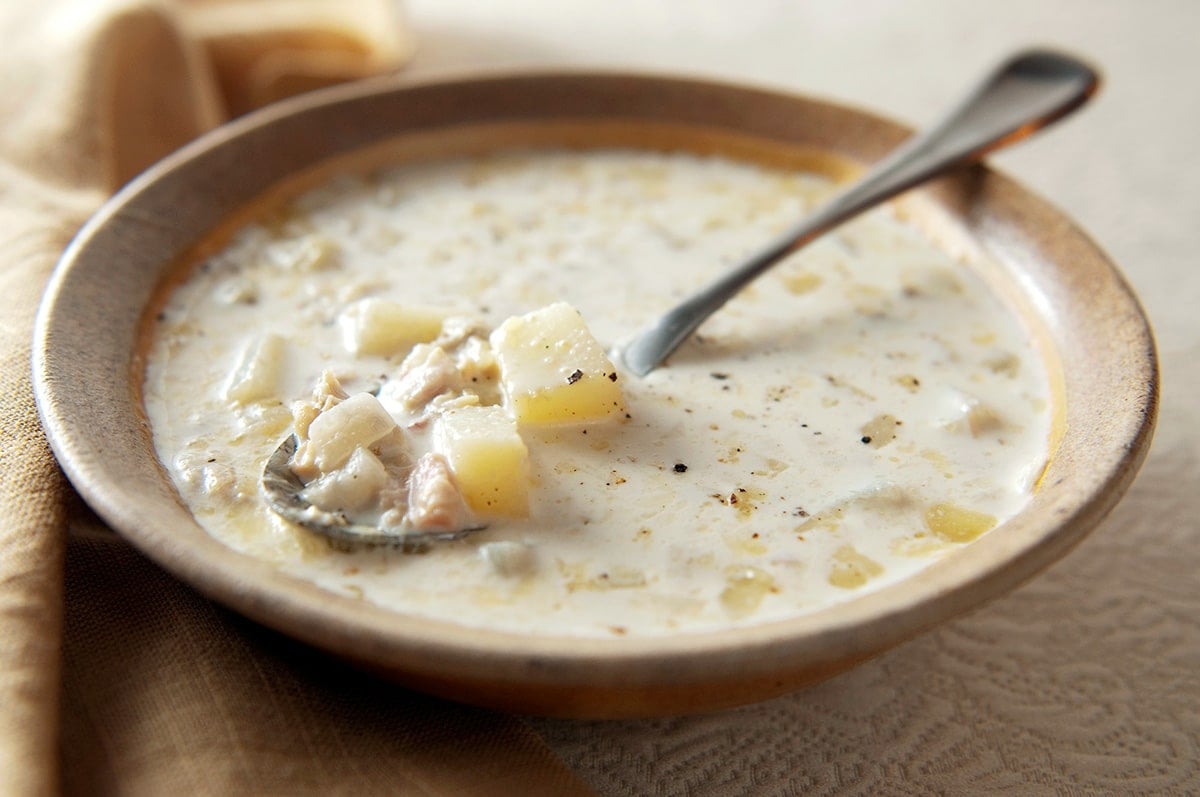
For the first 30-odd years of my life, I just thought mom’s chowder was unique to our family. It is a white chowder like most New England versions, but unlike the chowders in much of Massachusetts, mom’s is soupy and brothy, not thick and creamy.
It was only when I delved more seriously into food that I realized this was a recognized variety of chowder; it’s a Maine clam chowder. I asked mom about this, and she reminded me that her mother grew up in Wiscasset, Maine. Mystery solved.
Looking back on all this, I am struck by how important it must have been for mom to raise us all as bona fide clam lovers, even though it was not something she herself still liked to eat. It was both an act of regional pride (Yankees eat clams. Period.) and, more importantly, an act of love.
I am thankful for that, and for all the other acts of love mom has shown me over the years, both large and small. Every time I eat this particular New England clam chowder, I think of her. I love you, mom. Happy Mother’s Day. I hope I did your chowder proud.
Maine Clam Chowder
Ingredients
- 2 tablespoons butter
- 1/4 pound salt pork or bacon, minced
- 1 large onion, about 1 1/2 to 2 cups, chopped
- 2 pounds potatoes, about 3 to 4 cups, peeled and diced
- 1 quart clam juice
- 1 pound chopped clams, about 1 pint
- A 12-ounce can of evaporated milk (do not use lowfat milk)
- 3 cups whole milk
- Black pepper to taste
Instructions
- In a large soup pot, heat the butter over medium heat and add the diced salt pork and onions. Fry this slowly until the the onions are soft and translucent. Do not brown the onions.
- Mix in the potatoes and the clam juice and add enough water to just barely cover the potatoes. Bring this to a simmer and cook until the potatoes are tender, about 15 minutes.
- When the potatoes are just about tender -- not completely cooked -- add the chopped clams and turn off the heat. Let this cool for at least 30 minutes. You can make this chowder base up to a day ahead if you'd like.
- Once the chowder base is pretty cool (below 100°F), add the milk and evaporated milk and turn the heat on low. Gently bring the chowder up to eating temperature, and be very careful not to let it simmer. Add some freshly ground black pepper to taste and serve hot.
Notes
- A word on the clams. I am using gaper (horseneck) clams from California because that's what I have. A real Maine chowder uses quahogs, which are the dominant clam in markets on the East Coast. Canned clams are OK, too, although not as good.
- Eat this chowder with Yankee cornbread -- mom calls it johnnycake -- and a salad.
- Oh, and I'll leave this here as a final note: If you are scared of the possibility of your chowder curdling, skip the 3 cups of whole milk, add more clam broth or fish stock to replace it, and pour in at least a half pint of heavy cream. That's foolproof.
Nutrition
Nutrition information is automatically calculated, so should only be used as an approximation.
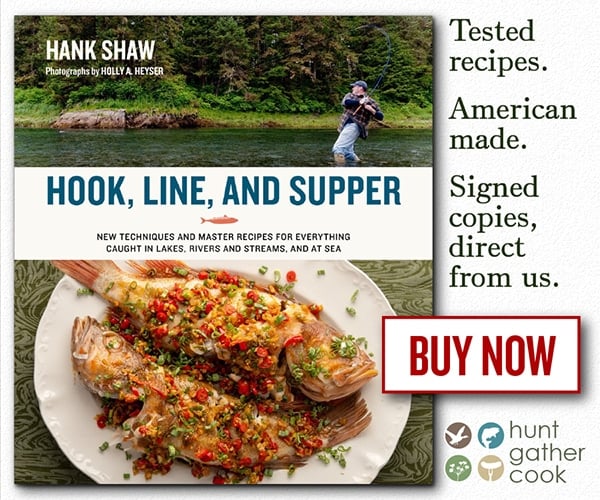
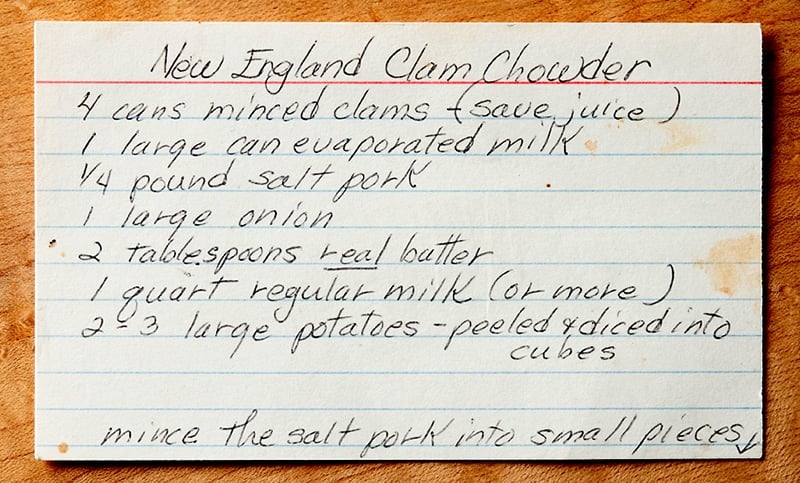
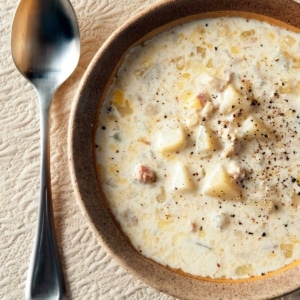
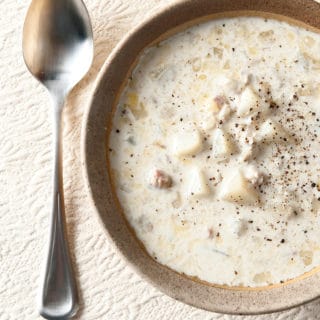
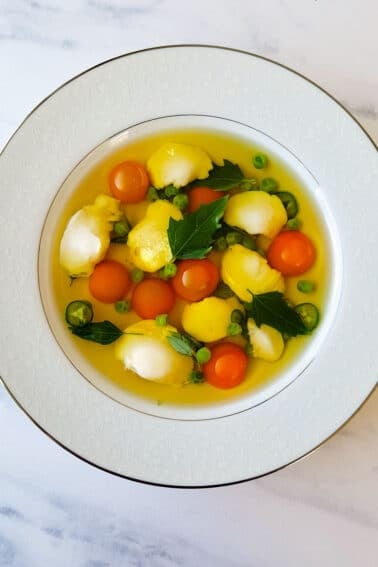
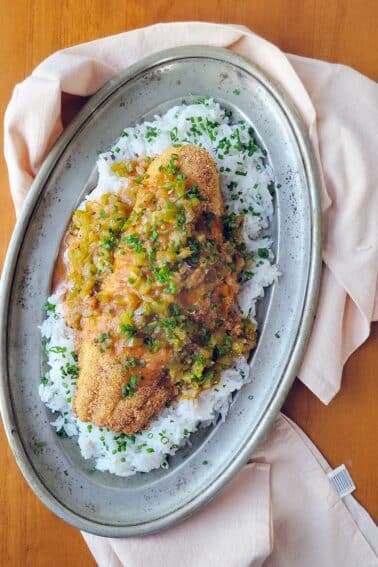
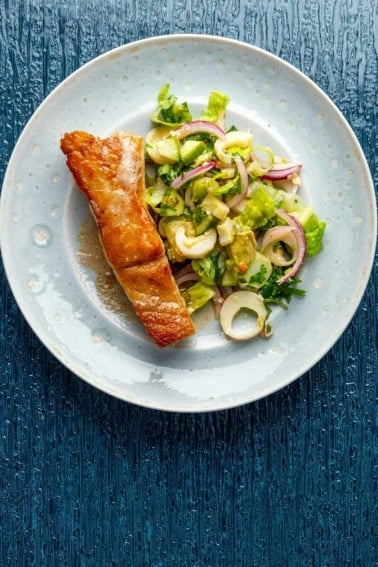
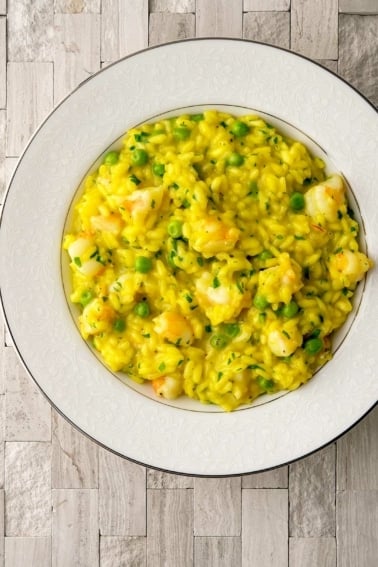
Delicious ! Thanks to our parents and Grandparents who pass down the most loved food recipes and memories. My mom also made it more like yours. Thinner with perfect flavor!
Made this today. It was delicious. The whole family loved it. Thank you for sharing the recipe and the story behind it!
Amazing flavor. Followed the recipe as written. I normally make a thick creamy chowder but this did not disappoint. I’ve been following you for some time. Love the smoked salmon recipes. Thanks!
Just like my family’s chowder except we didn’t use bacon or salt pork. Always included evaporated milk. Served with oyster crackers. We made homemade beans every Saturday too! Thanks for posting this authentic recipe.
I made this and loved it! I am accustomed to making a thin béchamel sauce for my clam chowder, but wasn’t needed here, and totally delicious.
If I choose to go the heavy cream route, do I skip the condensed milk as well as the 3 cups of whole milk?
Nancy: Yes, you do.
Thanks. I’m abut ready to test my attempt at this recipe!:-)
Very similar to my late Dad’s chowder. He added celery to his and only used canned milk and always bacon, lots of it too
I recently read Hook, Line, and Supper and loved it. I also read Pheasant, Quail and Cottontail. I got both through my local library. Good Job on both!!
I have searched for a recipe that could closely replicate the chowder I ordered multiple times while at the Black Pearl in Newport, RI while living there many years ago; I never forgot it . They finally told me, after intense questioning, that their “secret “ ingredient was evaporated milk. I have followed your recipe tonight and I think I’ve found it! Absolutely delicious and not terribly thick like so many other chowder recipes. I like this creamy, but brothy version. Going into my favorites file. Thank you!!!!
Thanks for thus recipe, the evaporated milk is a nice addition. Except for the evaporated milk, this recipe is identical to my mom’s recipe. She grew up in Scituate, Mass. (I’m a Texas boy but have a pretty good handle on New England cuisine thanks to her). The only other difference in her recipe: she would finely dice the salt pork, cook it until crunchy and set aside, then use the oil and some butter to saute the onions. The salt pork was sprinkled on top along with oyster crackers when the chowder was served. This recipe is so simple yet so good, great even with canned clams.
Absolutely delicious, this will be my go to recipe from now on.
I’m from Massachusetts and this is the kind of clam chowder I grew up with!
Hi. I am from Topsfield and fully familiar with Ipswich and Essex and the ins and outs of NE chowder and NY chowder (I can go on and on about this…). RI for that. I have a question about this recipe and original ways. I get a pound of chopped clams. But if all your Mom can get are the clams that you will shuck, where did a quart of clam juice come from? I am guessing that your Mom, bless her, only used the juice, and carefully collected, from the nasty shucked clams. I would really like to see the original recipe as they weren’t going to the local market in those days to ensure they had a quart of clam juice. This is , however, a great recipe. How many quahogs??? does it take to get a quart of clam liquid?
Sorry, but I’ve spent a lot of time around a number of people who did the exact same thing growing up.
All the Best,
Tim
Real deal clam chowder, and it’s already gluten free to boot. My partner is allergic to casein, so I made some adjustments for his dietary needs. The step of letting the broth part cool makes it easy for us to have our separate chowders, dairy-full for me and dairy free for him.
Vy: Dairy free means it’s Rhode Island clam chowder, which is basically this recipe with no dairy. 😉
Hi to all…… As a young lad, now in my late 80’s from Ipswich in the UK, I had an upbringing very much the same as your’s. We were taken by our mom to the marsh area of the Wash (Borders between Norfolk and Lincolnshire) to collect clams, mussels and most of all Samphire. As this was in the ww2 era and food was rationed, this was a very welcome extra to our diet and as for the chowder, the recipe we used came from the GI’s stationed nearby for which I can now say ‘ thank you guys one and all’.
Great recipes for shellfish tried some of these and they went down a treat
Hi Hank,
I came across your recipe while researching clam chowder recipes looking specifically for versions that use evaporated milk (I think this is a Maine thing?) as I had a version like this at Eventide Oyster in Portland, ME that as a Bostonian I had to admit was maybe the best clam chowder I’ve ever had. They use a few non-traditional ingredients as well but wow, what a chowder! Legal Seafood’s version has always been a solid benchmark for me for chowder and B&G Oyster in Boston’s South end does an amazing one, as does The Mariner in Mystic, CT. I shall try evaporated milk in my next chowder. I have to say that I’m a fan of both a thicker style and a thinner one, mood or weather depending (Just please not the San Francisco style in a sourdough bowl where the spoon stands up in the chowder) That is just not right. Ditto Manhattan style. I mean who eats that?
.
Your Mom’s Clam Chowder recipe is what I was raised on in Essex County, MA. How about sharing her Clams Casino recipe?
Rob: I did. It is in my first cookbook, Hunt Gather Cook. 😉
I was told that clam chowder was all about the clams, not the potatoes! The first time I made this was while in college during the 70s. I was given a HUGE bag of littleneck clams so I thought “why not clam chowder?” I was scolded by a NE person because the potatoes were too big and there were too many. After that, my size for the potatoes are 3/8 inch cubes…lots of clams and not thick at all. Yep, it’s all about the clams.
Is this the recipe of the clam chowder we had at the party in June.